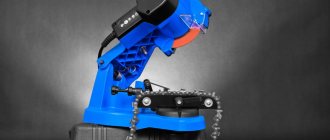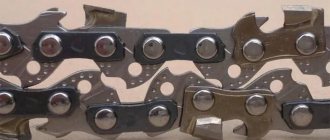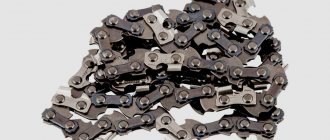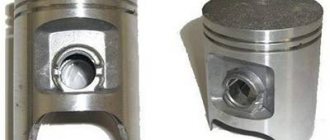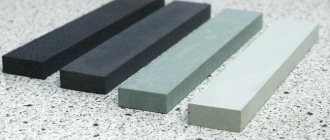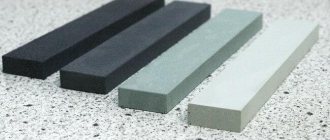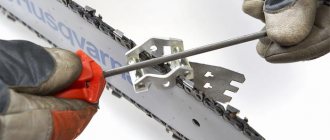Chainsaw chain sharpening template
When purchasing a chainsaw, it is advisable to acquire a special template (see Fig. 3), with which you can easily set the optimal values of the tooth angles.
It is used to control the values of the rear angles of the upper and end blades, as well as the front edge angle (it is indicated in the manufacturer’s instructions and can vary within 65...80°). It is especially important to use a template to estimate the clearance angle of the upper blade. This chainsaw chain sharpening angle is otherwise very difficult to determine, and yet it must be maintained within fairly limited limits - from 50 to 60°
The sharpening angle is measured by determining the angle between the top cutting edge and a line perpendicular to the chain guide.
The sharpening angle of the chainsaw chain can be changed, depending on what work will be done. As the hardness of the wood increases, its value should decrease. In general, the optimal angle value is 10...12° for longitudinal cutting, and 25...30° for cross cutting.
Figure 3 – Appearance of a template for sharpening chainsaw teeth
Sharpening can be done manually using a round file with a working diameter of 4...5.5 mm, or on a machine
In the first case, it is extremely important to correctly position the tool relative to the tooth being sharpened. The upper edge of the working part of the file is located approximately a fifth above the upper edge of the tooth
The tool is positioned perpendicular to the chain axis, and at an angle of 25...30° to the upper edge of the tooth
One round file is not enough. To sharpen the limiter, you will need a flat file, and to clean the work area, you will need a hook that removes the sawdust that forms. There are also special holders on sale, on which the lines of direction of movement of the file relative to the chain axis are graduated. As can be seen from Fig. 4, the holder can be installed on the tooth from above, and rest on its upper edge. Since the height of the holder is adapted to a certain chain pitch, it should be selected in relation to chainsaws of specific models and brands.
The minimum required set to obtain the correct angle for sharpening a chain manually is shown in Fig. 5.
Figure 5 – Set of sharpening tools and accessories
First, the teeth of one direction are sharpened, and then the other. Start by lightly pressing the tool away from you, gradually increasing the load. During sharpening, the round file is periodically rotated along its axis.
External signs of a dull cutting edge of a chainsaw tooth
Let us recall that a chainsaw tooth has a complex configuration (see Fig. 1), which also depends on the direction of movement of the chain. It has two working edges: a side edge, which is located perpendicular to the axis of movement of the links, and an upper edge, located at a certain angle to the direction of movement of the chain. In addition, a limiter is provided on each tooth, the parameters of which determine the height of the chips removed. Since the main cutting force falls precisely on the working angle, all subsequent work with the tool will depend on the angle to which the tooth is sharpened.
Figure 1 – Functional parts of a chainsaw tooth and their appearance
Before starting long-term work with a chainsaw, it needs to be inspected and test sawed, as a result of which:
- Visually determine the presence (or absence) of a conical section adjacent to the corner of the tooth, as well as a radius rounding on it - the main signs of blunting (see Fig. 2).
- Check the feed force at which the tool operates steadily and produces a quick cut. For sharp teeth, the initial moment of penetration of the tooth into the wood occurs quickly, and without significant resistance to the material.
- Find out the presence of chain vibrations during a steady cut - if they are noticeable, then the teeth need to be sharpened.
- Inspect the appearance of the newly cut end (especially if the tool is used for rip sawing). If there are rough chips and dents, the chainsaw chain must be sharpened.
Sharpening with improvised means
To properly sharpen a chainsaw chain with a file, you need to prepare tools to restore its functionality:
- round file;
- flat file;
- holder;
- correcting machine for teeth.
A round file is needed for processing the edges of saw teeth characterized by a rounded configuration. Typically, a tool with a diameter of 4 - 5.5 mm is chosen. A flat file is needed to sharpen the depth stops, which determine how much the chain cuts into the wood structure.
Files for sharpening chain Source www.stroyportal.ru
Features of the chain structure
To effectively be able to sharpen a chainsaw chain, you need to know the structure of its teeth. You can’t do without knowing the sharpening angle. Each tooth has a complex structure. Its geometry is represented by the following components:
- basis;
- spatula;
- depth limiter.
In this case, the blade consists of two blades: the end blade and the top blade. Moreover, between them there must be the correct sharpening angle of the chainsaw chain in order to provide it with the necessary performance.
As you can now guess, it is not the chain that cuts the tree, since it serves as the basis for securing the cutting links and moves them at high speed. The links themselves have sharp blades, with the help of which the wood is cut.
Files for sharpening chainsaw chains Shtil 180
First, it is important to buy the right file for the job, if you are using the Stihl 180 model, the round file will have to be selected based on the chain pitch (0.325 inches), the presence of notches and the length of the file itself. Based on the GOST 1465 standard, round files are classified by length by number. The following files are ideal for the Shtil 180 brand:
No. 4 - working length 200 mm;
No. 5 - working length 250 and 300 mm.
The second option is more suitable, because the longer length will make the sharpening procedure convenient and effective.
Notches on round files can be of two types - notched and cut. We recommend choosing notched ones due to the smaller cutting angle range. The most suitable files are those made from tool steel; we recommend products from the Zubr brand. The manufacturer creates them specifically for handmade work and offers many different sizes.
Chain sharpening procedure
First of all, place the chainsaw on a flat surface, at home it can be a table; when working in the forest, a large block of wood is perfect
It is important that the chain is tensioned when sharpening, otherwise the procedure will be a failure. Sharpening takes place in the following stages:
A round file is installed in a perpendicular direction when moving the teeth on the chain in a vertical position; if the teeth are in a horizontal position, the file is installed at an angle from 15 to 200 degrees. For horizontal teeth, you can use a holder.
For the procedure to be successful, when installing the file into the tooth throat, make sure that it is installed just above the edge; 1 mm is enough;
The third stage is installing the holder on the tooth. The lines on such a tool will show the correct direction of movement of the file in a horizontal position.
Once positioned correctly, you can make a couple of strokes with the file until metal shavings form. The shavings are removed with a previously prepared hook;
You need to sharpen the chain in a position away from you; with the correct choice of file diameter, the notches should fit smoothly into the tooth.
For better efficiency, sharpening is carried out through 1 tooth, in the opposite direction the process is carried out along the missing teeth.
It is important to always apply a little pressure on the file during the procedure, this will increase the amount of chips removed and speed up the process
Manual machine
For those who do not like to go into details and do the above sharpening of the chain with their own hands using a file, you can give preference to a manual machine. This machine is based on the same file and can be replaced with a suitable diameter in a few seconds. This machine is attached directly to the tire; if necessary, there is a function for adjusting the sharpening angle. The machine is capable of creating a stop that will hold the tooth while sharpening. A good device that is low cost and easy to use.
The machine is used by both novice craftsmen and experienced workers with chainsaws. The cost of the machine is significantly higher than that of expensive electric models. It is recommended to purchase a standard Stihl manual lathe.
Modern method
Almost every non-professional is concerned with the question, what is the angle of sharpening the chainsaw chain on the machine? You won’t be able to use a file all the time, it’s difficult to use an angle grinder, and for beginners this procedure is downright dangerous. There’s nothing you can do about it; you have to use machines that can be either mechanical or electric.
You will have to work for an “eternity” with a manual machine, but you get pleasure from using an electric analogue. Today there are a wide variety of models to choose from that provide
- correct sharpening angle;
- high level of work quality;
- high sharpening speed.
It is also worth noting that sharpening is carried out evenly on all links. All you need to do is turn on the equipment, set the desired angle, enjoy the spectacle, or do other things. The cost of such machines varies from 2 to 4 thousand rubles. But the most important thing is that it will not be difficult to determine the sharpening angle of the Shtil chainsaw chain on the machine.
Although fiddling around with manual equipment is a very lengthy process, it costs several times less. In appearance, the machine resembles a bow saw, only instead of a blade there is a round file. The smallest tooth is also used as the basis. In this case, two or three movements are enough for sharpening, after which you can move on to the next link. If necessary, process the limiter - change the file (round is replaced by a flat one).
Husqvarna chain sharpening combination template
Proper chain sharpening
the Stihl
chain as an example .
And also an example of stupid chains, an example of my saw
, and reasoning.
The sharpening angle of a chainsaw chain depends on the main purpose of the tool - for transverse or longitudinal sawing. Since during longitudinal sawing the resistance of wood is always noticeably higher, the edge of the tooth must be very sharp. It is recommended to do it in the range of 6...12° (for comparison - with a predominance of cross cuts - up to 25...30°). Naturally, in the first case, sharpening should be done more often, and especially carefully, since an unacceptably small angle of inclination of the tooth contributes to its rapid chipping when using a chainsaw.
This is especially important for links that are made from structural alloy steels containing silicon and manganese, for example, 40ХГС or 35ХГСА
Features of the chainsaw
Cutting wood is similar to working with a plane. In this case, the size of the cut depends on the thickness of the limiter. When the saw chain works hard, the teeth become dull faster. This is clearly manifested when the ground surface appears in the path of the chain. To completely dull the teeth, it is enough to “catch” on the ground for a couple of seconds.
If you sharpen it as often as possible, the chain will last much longer, since very little metal will be removed. In addition to the question of what angle of sharpening the chainsaw chain should be, you should also know this!
Working with a dull tool is undesirable for a number of reasons. First of all, this affects the quality of the cut, and not for the better. Fatigue also quickly sets in, which is felt not only in the hands, but also in the body.
Another reason is unjustified excess fuel consumption. All parts will work in increased mode, which inevitably leads to rapid wear. Performance drops seriously, which also happens when using a defective chain.
Useful recommendations from experts
To prevent premature chain wear, you need to follow the advice of experts. Experienced professionals advise:
break in the chain before sharpening. To do this, you will first need to run the headset at low engine speeds
After complete cooling and restoration of the chain, you will need to adjust it on the bus; regularly inspect the saw element, paying attention to its tension and condition. When sawing wood, when the chainsaw is tilted to one side, the saw set takes on increased loads
Due to poor tension, the cutting teeth may become unusable; remove shavings and other wood waste from the cutting set in a timely manner; try to prevent the chain teeth from getting on nails and other hard objects; sharpen the saw element on time - if the chainsaw is not used regularly at home, the operator will only need one procedure per 3 months of use. If the tool is intensively used in forest felling, then the headset will need to be restored at least once every 2–3 weeks; Do not use the chain immediately after sharpening it. The headset needs time to cool completely. If necessary, the process can be accelerated by using compressed air cylinders. Before installing the part back onto the tire, it will need to be dipped in clean oil. This will make the cutting element more mobile and significantly extend its service life; Use only high-quality branded oils for lubrication. Filling with used lubricants is not allowed.
Grinding angles and saw tooth configuration
The cutting edge of a tooth is characterized by the following parameters:
In addition, each tool model has its own tooth pitch, the value of which for home and semi-professional models is associated with the power of the chainsaw and the torque that the drive develops. For example, for rip sawing, the pitch is smaller (eg 0.325 inch). Productivity will be reduced, but the effort required will be significantly lower. The upper values of the stages for home gas stations are extremely rare, mainly when cutting down trees with a large trunk diameter. The motor power should not exceed 2500 W.
Methods, methods and devices for sharpening
If you use the saw irregularly, it is advisable to resolve the sharpening issue with the help of service departments. Specialized tool shops provide such services everywhere. The cost of the issue is usually low, but sometimes complaints arise about the results of the work performed. If you want to get high-quality chain sharpening, you should take this issue into your own hands. Let's take a closer look at how to do this.
There are several types of chain sharpening methods:
- manual using a plank and a file;
- manual using a grinder;
- manual sharpening machine;
- automatic sharpening device for chainsaw chains.
In order to decide on the sharpening method, you need to evaluate the intensity of use of the saw. If working with a tool is sporadic, then it is enough to have the simplest sharpening devices on the household. The least expensive method is manual, carried out using a special round file and a strip.
The sharpening operation can be a little more expensive using a grinder. But considering that this tool, as a rule, is always present in the arsenal of masters, the price will not be much more.
If gasoline and electric saws are widely used in work, it is advisable to purchase an industrial sharpener. There are two possible options:
- with manual chain movement;
- with automatic feeding.
Let's take a closer look at each of them.
Using a file and plank
In tool stores you can purchase the simplest and most inexpensive device for sharpening chainsaw chains. It consists of only two components - a strip and a file. The bar is designed to ensure the correct sharpening angle. It is attached directly to the chain and serves as a guide for the round file. The sharpening process, of course, is somewhat tedious and requires certain skills. But in terms of cost, this is the cheapest option. And if you have some experience, you can get a fairly high-quality result.
Manual sharpening with a grinder
To safely use an angle grinder to sharpen a saw, you need to make a chainsaw attachment with your own hands. Its essence is to secure the angle grinder, ensuring its immobility. Or you can fix the chain with a mandrel, but this option is more labor-intensive, since it must be moved periodically to provide access to all the teeth.
Some craftsmen manage to sharpen a chain without removing the saw from the bar. But this requires special dexterity and skill, because it is quite difficult to choose the recommended angles with an angle grinder suspended.
You can secure the angle grinder either in a vice by its handle, or using a homemade stepladder holding the tool by the body. The result is a device that resembles a garage emery machine.
Having secured and started the device, you can proceed directly to the process of sharpening the chainsaw chain with a grinder
And here it is important to correctly guide the teeth, maintaining the required angle and depth of entry of the sharpener. Experimentally determine the time of exposure of the emery wheel to the tooth, preventing it from overheating and loss of hardness
The result of the work performed depends on the dexterity and skill of the performer. The chain being sharpened has only one support - the master's hands. This means that he exclusively sets the sharpening parameters, and the success of the process depends on his skill. The biggest disadvantage of this method is the increased risk of injury.
Using a chainsaw attachment
The most common sharpening device is an industrial device with an electric motor, on the shaft of which an emery wheel is installed. The engine is hinged on the frame and has the ability to be driven to the teeth of the chain, which, in turn, is fixed in special brackets that allow it to be moved by bringing it under the grinding wheel.
This design is very simple, accurate, safe and productive. The process goes quite quickly, since there is no need to monitor sharpening angles. And the depth and time of cutting are successfully controlled by the operator.
Automatic sharpening machines
There is almost no fundamental difference in the design of automatic and manual machines. An automatic broaching unit has been added, allowing human participation in the process to be reduced to a minimum
It is only important to install the chain correctly and start the machine. An important feature is the ability to adjust the tooth sharpening angle, which allows you to sharpen chains from various manufacturers
PowerSharp system
This system allows you to sharpen the chain in a few seconds, without even removing it from the bar. The set includes a PowerSharp chain, an abrasive bar,
and sharpening device. In order to sharpen a chain with it, it is useful to take the following 3 steps:
- install the PowerSharp bar and chain;
- fasten the beam inside the sharpening device, after which it is installed on the tire;
- The end of the chainsaw is rested on some object and started for a couple of seconds.
How to sharpen a chainsaw chain?
In this article we will figure out how to sharpen a chainsaw chain. It must be said that sharpening chainsaw chains is perhaps somewhat more difficult than sharpening any other cutting tool. In addition, high-quality sharpening is only possible if you have special sharpening devices. Let's start with them, and then we will also look at automatic systems for sharpening chainsaws.
And how to sharpen a chainsaw chain correctly?
If in the process of work there are non-uniform chips. a huge amount of dust and sawdust has a needle-like shape, this is a sure sign that the chain needs to be sharpened. Do you need to sharpen your chainsaw chain yourself?
The cutting link is a rather complex part of the saw chain in its own structure.
The saw chain consists of 2 parts:
cutting depth limiter
cutting element with an L-shaped cutting angle.
The properties of the cutting link are influenced by the following reasons:
top edge sharpening angle
cutting angle
side angle
depth limiter height.
When sharpening a chain, it is necessary to take into account all the reasons listed above. A small deviation can cause unnecessary hassle
What tools are needed to assemble a tool for sharpening chainsaw chains with your own hands?
It's simple:
round ratfil
thin ratfil
combined template (available in supermarkets)
vice (better)
Voila. We have an almost ready device for sharpening chainsaw chains.
How to sharpen a chainsaw chain? It’s painfully simple. First, clamp the saw in a vice. We start sharpening with the cutting teeth. Next, you should apply a sharpening template to the chain. There are arrows on the template; they should point in the direction of rotation of the chain. Do sharpening with smooth movements; forward movement should be carried out at an angle to the chainsaw awl. The tilt angle is selected depending on the chain pitch. Each tooth must be sharpened identically. That is, the number of movements should be approximately comparable. It is necessary to sharpen one by one, one tooth on the right and one on the left.
Fundamentally: after you clamp the tire in a vice, it is easier to first sharpen every 2nd tooth on one side and then every 2nd tooth on the reverse side.
Apply a template for the stopper tooth and sharpen the stopper tooth with a file (flat) to the level of the template. The template has several provisions, specifically two:
H-hard for hard wood (such as oak)
S soft for softer breeds.
Fundamentally: the limiter tooth cannot be sharpened without a template, this will lead to this. that you cut very deep, in which case the chain
will begin to cut a very thick layer of wood. In turn, this will increase recoil and reduce the accuracy and precision of cutting.
The teeth of the chain must be sharpened identically (in length). The guideline for this is the length of the tooth itself that has become dull. It is necessary to measure the length of the visor of the blunt tooth. The angle between the blade and the side should not be changed. According to all standards, the angle should be ninety degrees.
When sharpening a tooth, its hole expands from the inside; you need to make sure that the base is horizontal.
Ratfil must be selected for each chain individually. For example, low-profile chains are sharpened with a four mm ratfil.
If for some reason you don’t want to sharpen it yourself, there are devices and special tools on sale. sharpen the chain correctly
chainsaws yourself with the least amount of time.
For example, sharpening machines. which are attached to the tire:
Or an electronic machine:
The answer to the question of how to sharpen a chain
chainsaws, also found:
The best prices for equipment and tools. Features of chainsaw service
The chainsaw tooth has a complex shape of two edges: angled top and side
This tooth structure requires caution and accuracy when carrying out work. When a chainsaw chain needs to be sharpened, the following symptoms occur:
- the saw begins to move from side to side;
- the speed and efficiency of work decreases;
- the appearance and configuration of the chips changes.
There are no specific deadlines or regimes for the constant sharpening of a chainsaw chain. Everything depends on the intensity of use of the technology and its initial multifunctional features. Having previously researched the main conditions and rules for carrying out work, in principle, any person will be able to sharpen it in the shortest possible time. You should not only figure out how to sharpen a chainsaw chain, but also prepare special devices, the choice of which depends on the priority operating technology and type of equipment.
Sequence of operations when sharpening
High-quality sharpening of teeth requires strict adherence to the following rules:
- A file for sharpening a chainsaw should be placed strictly perpendicular to the direction of movement of the saw teeth in the vertical direction, and at an angle of 15...20 0 in the horizontal direction. The latter is controlled using a holder.
- The round file in the tooth mouth must be located slightly above its edge (for file No. 5 this is approximately 1...1.5 mm).
- A holder is installed on the tooth, the lines of which will show the exact direction of movement of the file in the horizontal plane.
- After several movements of the file, the sharpening surface is covered with magnetized shavings, which should be immediately removed with a hook.
- Sharpening begins in the direction away from you, without using excessive force: the notches should gently enter the metal of the tooth. It is recommended to make several movements and then turn the file by 20...30 0 so that the wear of the notches occurs more evenly.
- It is recommended to sharpen “through the tooth”: first sharpen the teeth in one direction, and then in the other.
- The pressure on the file during sharpening should be constant, as should the number of reciprocating movements on the tooth being sharpened.
When sharpening the depth limiter, proceed as follows. A template is applied to the limiter. When the stopper slot fits into the template groove, set the height of the worn area, which is removed using a flat file. The template is installed on one of two sides - Hard or Soft, which corresponds to hard or soft wood.
Sharpening will be easier if the chainsaw bar is clamped in a bench vise. The intervals between sharpenings can be increased if you promptly monitor the correct chain tension, monitor the condition of the limiter, regularly lubricate all moving elements, and periodically replace the drive sprocket.
“A lumberjack working with a blunt ax was advised: “Sharpen the ax.”
He replied: “There is no time.” The forest needs to be felled. »
Hello to all readers!
Today I decided to tell you about an instrument that, it seems to me, is simply impossible today. A good tool should work well, and this largely depends on its owner.
Cleaning the autumn garden, preparing firewood for winter, building a bathhouse, and repairing a wooden fence will require not only time and desire, but also the availability of a “cutting” tool. If this is a chainsaw, then it must be properly sharpened.
Of course, there are paid specialists, and you, for example, have extra money... But we know that such a procedure is performed periodically and therefore a natural question arises: how to sharpen a chainsaw chain at home? I’ll tell you about that. Go!
From this article you will learn:
Manual method
This is the simplest and slowest method for sharpening chain teeth. However, the method is good when sharpening is done on site in the forest. Why not carry a whole machine with you all the time?! But here it’s worth being more precise - we don’t mean one tool, but a whole set, which includes:
- flat file;
- round file;
- sample.
Each of them performs their duties. The main purpose of the flat tool is to sharpen the depth gauge.
A round file already performs the main operation, making the cutting edges sharper. In this case, each chain requires a certain tool diameter:
- pitch ¼ inch - 4 mm;
- pitch 0.325 – 4.8 mm;
- pitch 3/8 inch - 5.2 mm;
- pitch 0.404 - 5.5 mm.
For Picco chains, which are equipped with Shtil 180 chainsaws with 3/8 and quarter inch pitches, a file with a diameter of 4 mm is also suitable. It is important to hold it correctly. With respect to the vertical plane, the file must be positioned strictly perpendicular to the chain, and with respect to the horizontal plane - at a slight angle (about 30°). The specific sharpening angle is selected depending on the needs, but within 25-35°.
Unlike sharpening a chainsaw chain on a machine, the angle here can be set using a template, which is considered a useful assistant. For this purpose, it is equipped with two slots: SOFT/S (for soft wood) and HARD/H (for hard wood). The template must be secured above the chain, which gives it the privileges of a limiter.
Just keep in mind that this method is not intended for permanent use, but serves only as a straightening of the blades. Using a file too often will wear out the chain over time, and the teeth themselves will be sharpened unevenly.
Reasons for rupture of the saw set
From time to time, while working with a chainsaw, the headset may break. This phenomenon is not uncommon, but does occur from time to time. There may be several circumstances, the first and most common is severe wear and tear. During operation, the edges rub against the bar, as a result, the metal is evenly worn away and the chain, unable to withstand the load, breaks.
Important! The introduction of high-quality adhesive oils can significantly extend the life of the saw set. The second reason is untimely replacement of the drive sprocket and saw bar; otherwise, replacing them separately
According to the advice given by domestic manufacturers, the saw set, guide bar and drive sprocket are made as a set. This will prevent wear, stretching and tearing due to excessive loads.
The second reason is untimely replacement of the drive sprocket and saw bar; otherwise, replacing them separately. According to the advice given by domestic manufacturers, the saw set, guide bar and drive sprocket are made as a set. This will prevent wear, stretching and tearing due to excessive loads.
3rd, this is a defect when sharpening with a special sharpening machine. The machine disk rotates at high speeds, which makes it incorrect to adjust the groove depth, or in other words, for some reason, the working stroke of the machine will increase, then a fraction of a second is enough to be able to cut the edges of the connecting link. If after sharpening you do not check its quality and the presence of cut links
, then when working under load, the cut link may break.
4th and last is the lack of rivets. A frequent prerequisite for breaking a chain is its incorrect connection, or, in other words, the re-introduction of connecting links. If your cutting set is torn, then information about how to actually connect the circuit will be very useful.
Related Posts
Chains, tires, sprockets. increasing service life
For owners of chain saws and chainsaws with devices for longitudinal sawing, the issue of extending the service life of cutting equipment that allows accounting (software) is very relevant. Large operating loads during longitudinal cutting lead to rapid wear of chains, sprockets, and tires. We will try to find out the main reasons for the wear of the saw set without, if possible, reducing them to zero.
1. Drive sprocket for chain sawmill
Let's start the debriefing with the drive sprocket, since it is this small part that experiences the maximum load, driving the cutting system of our sawmill (chainsaw). High-quality drive sprockets are made using powder metallurgy; they can withstand very heavy loads and are not abrasion-resistant.
But, alas, no unit lasts forever; despite such strength, the drive sprockets wear out quite quickly, gradually becoming unusable. Harsh operating conditions and higher loads during longitudinal sawing have an effect. After the initial grinding in with the saw chain, the working edge of the drive sprocket begins to wear out. When wear reaches a critical point, the sprocket collapses, breaking in half.
The service life of the drive sprocket depends on the length of the tire. the longer the tire, the faster the sprocket burns out (loads increase with a long tire). The service life of the drive sprocket is significantly reduced by strong chain tension, vibration loads and jerks, which can occur due to improper preparation of the chain, or, in other words, due to the design features of the sawmill. Here, chain sawmills with one tire attachment point are greatly inferior. Anyone who has worked at such a sawmill will understand us.
The cost of the drive sprocket is about five USD. the amount is small, so it is better to replace it if there are any doubts about reliability.
4. Tire for chain sawmill
With tires everything is much more complicated. Despite the fairly large variety of tires that could be used for longitudinal sawing of wood, we are mainly “fed” with Oregon tires (50cm / 1.3 / 3/8 / 72). At the moment this is the most common tire for chain sawmills.
Chainsaw chain design
- Left and right cutting teeth.
- Limiter (control of cutting depth).
- Leading link.
- Rivets.
To work comfortably with a chainsaw, you need to sharpen each tooth on the left and right sides. There are 2 main shapes of chainsaw chain teeth:
- Chipper is the most common form. The profile is rounded, so sharpening is done mainly with a round file. The chipper becomes dull quite quickly.
- Chisel - the profile of the tooth resembles the number 7, therefore, in direct contact with wood, due to the small contact area, the cut is easier and cleaner. However, when sharpening, this form is more of a disadvantage than an advantage.
Bulgarian is not a bad candidate
Professional woodcutters consider this method primitive and labor-intensive. It is used in the very last case, since it is impossible to fix the grinder on the template. Therefore, it is very difficult to achieve control over maintaining a constant sharpening angle and depth.
Read:
The tire is firmly fixed in a vice to prevent its mobility during operation. There is no need to attach a new cutting disc to the grinder; it is better to use an old circle 1.5-2 mm wide.
It is better for newcomers not to use this method at all - they will be safer. There is a risk of causing severe injury to yourself. In addition, there is no way to do this without the ability to work with similar equipment.
Signs of a worn chain
Signs of a worn chain
You can notice quite a lot of signs that directly indicate the need to sharpen the saw chain. This is both a decrease in performance and an increase in fuel consumption. Another important distinguishing feature is the reduction in the thickness of the chips flying out of the cut. Don't wait until it looks like dust.
The intensity of saw chain grinding is directly proportional to the frequency of use of the chainsaw. The hardness of the material with which you have to work, the presence of knots, the danger of the chain contacting the ground, iron, stone, etc. also matter.
The longer the cutting process lasts, the more the chain grinds down, and accordingly, the load on the body increases, which leads to wear on the drive sprocket and tire. From here it is not far to serious breakdowns that will require significant investments in repairs and replacement of spare parts.
This is important: not only the operational efficiency, but also the service life of the chainsaw depends on timely sharpening of the chain. The best solution in this case would be to resort to the services of a specialist who will do this professionally, using special equipment.
But a situation may arise when it is not possible to use the help of specialists. Well, this is a good reason to learn how to sharpen a chain yourself
The best solution in this case would be to resort to the services of a specialist who will do this professionally, using special equipment. But a situation may arise when it is not possible to use the help of specialists. Well, this is a good reason to learn how to sharpen a chain yourself.
Mechanized sharpening on a machine
Special tools that can be used to simplify the procedure have become quite widespread. Such machines are equipped with a special electric drive and grinding wheels with increased wear resistance.
A small tool is suitable for use at home. Such devices can be powered from a 220 V network, and the power consumption is 100 W. Installing a chain is quite simple; the sharpening procedure can be carried out even without special training.
When choosing a machine, pay attention to the following points:
- Adjustment of the sharpening angle within a certain required range.
- Possibility of processing chains with different pitches and cutting edge thicknesses.
- Features of the procedure for changing grinding discs.
- Control of the cutting width value.
- Power of the installed electric motor and energy consumption indicator.
Determining the need for sharpening and the consequences of working with a worn chain
The parameters of efficiency, quality and safety of working with a chainsaw directly depend on the condition of the cutting edge, which consists of complex teeth. The operation process is accompanied by dulling of the teeth, which negatively affects the speed and quality of the work performed. The period for sharpening cannot be standardized and set in advance; therefore, it is determined based on the results of an analysis of the following indicators:
- uncomfortable sensations when performing work;
- increase in time to complete work;
- increasing the required effort to feed the cutting tool;
- presence of vibration during operation and “walking” of the chainsaw in different directions;
- visually noticeable tooth wear.
An important rule, if it is necessary to correctly assess the condition of the chain and determine the sharpening period, is to control the type of chips obtained during the operation of the tool. With well-sharpened teeth, the chips have a uniform appearance, fairly large sizes and are closer to a square shape. When the teeth wear out, the chips become too small, almost dusty in size, and become darker in color.
Grinding angles and saw tooth configurations
As previously noted, the product in question is characterized by a rather complex configuration. Among the features of modern versions, the following points can be noted:
- The choice of chain for rip sawing is carried out for a specific chainsaw model, since the configuration largely depends on the power and some other points.
- For rip sawing, the cutting blade spacing is 0.325 inches. This ensures high stability during operation.
- The cutting edge can have a thickness of 1.3 mm. There are also versions on sale that have a thickness of about 1.1 mm, but they are difficult to sharpen at home. In addition, the small thickness allows cutting of thin branches.
- Attention is also paid to the profile height, which varies in the range from 0.625 to 0.762 mm. For domestic versions, the low profile version is suitable. This indicator determines the likelihood of vibration occurring at the time of sawing.
How to choose the right angle?
Cutting hardwood is characterized by low productivity and a large load on all components of the chainsaw (we recommend reading in more detail about the structure of the chainsaw). The most popular hardwoods are ash, beech, birch, elm, maple, oak and hazel.
The photo shows a special sharpening device that allows you to securely fix the file.
In order to effectively cut these rocks, it is necessary to maintain a sharpening angle of 25°. This value will ensure optimal operation of the chainsaw with average performance characteristics.
Softwoods include all conifers, with the exception of larch - spruce, pine, fir, cedar, as well as deciduous trees - alder, linden, aspen, willow and poplar.
For rip cutting
As already mentioned, the recommended sharpening angle is 10° with a possible deviation of up to 2°. This is due to the need to quickly cut deep into the tree when making a longitudinal cut.
For working with soft wood, the optimal angle is 25°. The fibers of soft wood are distributed unevenly, that is, hard ones alternate with soft ones. A value of 25° allows cutting of alternating fibers without periodically increasing the engine speed.
For cross cutting
For cross cuts in soft and hard wood, a value of 35° is recommended. This value allows you to achieve optimal power characteristics and load on the chain when cutting.
Angle table
The sharpening angles for saw chains are presented in the table below. From the table you can even understand which file will be needed to sharpen a particular chain.
Table of sharpening angles for all types of saw chains, as well as cutting depths. To enlarge, click on the photo.
Correct sharpening angle values
The sharpening angle of chainsaw chains is not a constant value and does not depend on the manufacturer or model of equipment. It is selected taking into account what kind of tree you will be dealing with. You can choose some average value, but the cutting efficiency may be ineffective. For this reason, it is necessary to choose the correct value, taking into account the specific type of wood.
Read also: Switching an electric motor from star to delta
If we are talking about solid wood, including those trees that have been “frozen” for a long time, it has a high resistivity. In this regard, the sharpening angle should be reduced. This will practically avoid the occurrence of vibrations, and the movement of the chain will be softer. The minimum value is 25°.
For soft types of wood, the sharpening angle can be increased, but not more than 35°. This will significantly improve productivity. As for the sharpening angle of the chainsaw chain for rip sawing, the value is 10°. In this case, the cut will be as smooth as possible, and equipment vibration will be minimized. Knowing these features, you can move on to considering different sharpening methods.
Chain saw sharpening template
To significantly simplify the procedure, it is recommended to purchase a special template, which greatly simplifies the procedure for setting the required angle. Such a tool allows you to check the indicator of the rear angles of the conical and top blades, as well as the leading edge of the cutting edge.
Experts point out that the most important thing is to use a template to control the clearance angle. This is due to the complexity of changing this indicator, and it must be maintained within a strict range
Too high a material hardness determines the need to reduce this indicator. Experts indicate that the optimal value varies from 10 to 12°.
How do you know when sharpening is needed?
You can determine whether the chain teeth have been ground down or not by looking at some characteristic signs. Of course, it all depends on how intensively the chainsaw is used. It’s worth taking a closer look at what kind of shavings it leaves behind. Its uniformity and square shape indicate sharp teeth. If the chain is worn down, it usually leaves behind wood dust, and the sawdust itself resembles the needles that a hand saw “produces.”
If the cutting speed is reduced, then this is also considered a sign of a dull chain. You can feel an increase in the load on the instrument itself and the appearance of vibration. Beginners may not always be able to spot some of these signs. Therefore, they should pay more attention to the quality of the chips. Sometimes it can be brown, which is a guaranteed indication that it’s time to sharpen the chain.

